ABSTRACT
Urban Rights is a term which has been coined by the philosopher Henri Lefebvre (Lefebvre, 1967) and further
explored by David Harvey (Harvey, 2003). It is a concept of a collective right to change the city and shape the
process of urbanization. Thus, the right to the city does not merely address what the city already has to offer,
but also to the capacity to change and alter the city.
In the meantime, in the past few years, our cities have been attracting many wild species from their surrounding
natural environment. Particularly, the arrival of wild boar in Barcelona’s squares and city parks has been forcing us to face a
new reality: we are exceeding the limits of urbanization and this is a crisis we have largely constructed by ourselves.
City sprawl is driving the species out of their natural habitats and makeing them live alongside us.
This study aims to highlight the urgency of environmental connectivity through rewilded landscapes given
back to nature as part of wild species rights to move across their natural habitat by being also seasonal users of
the peri-urban areas of Barcelona. By identifying the possible conflicts between human and boar activity as well
as by locating the four areas with the highest natural connectivity, this project explores the potential of land types
and the built space to be transformed into rewilded landscapes. Finally it uses one of them as a case study in
order to further develop its potential. By creating rewilded landscapes, the “Wild Deal” takes into consideration the
ways that both human and boar could benefit from the adaptation of wildlife to peri-urban environments
and vice versa.
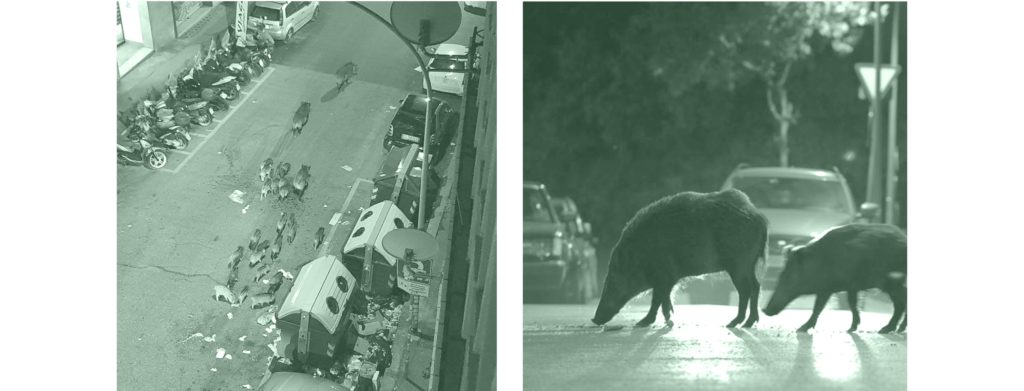
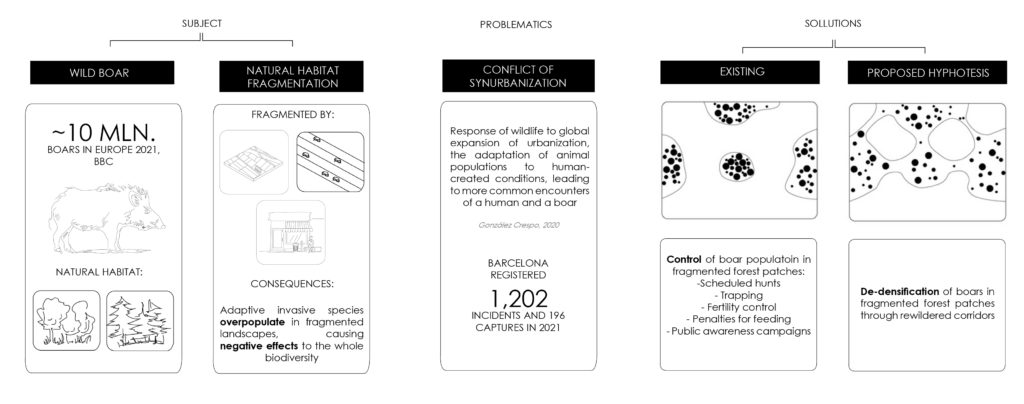
SYNURBANISATION OF THE BOAR
Currently there are around 10 mln boar in Europe that tend to spread to urban and peri-urban environments in
search for food. This is how the conflict of synurbanisation emerges, forcing wild boar to become adapted
to human-created conditions. This is a big problem which can be illustrated with the example of Barcelona
itself- over 1200 registered boar incidents in 2021.
In order to control the boar population, several main strategies exist. Barcelona even has an action plan on boar control
that involves scheduled hunts, trapping, fertility control, penalties for feeding and public awareness campaigns.
Some scientists emphasize that these traditional practices are insufficient and we need more innovative solutions.
That is why and try to challenge the existing human-centered attitude and raise a proposal of de-densifying
boars in fragmented forest patches through rewildered corridors.
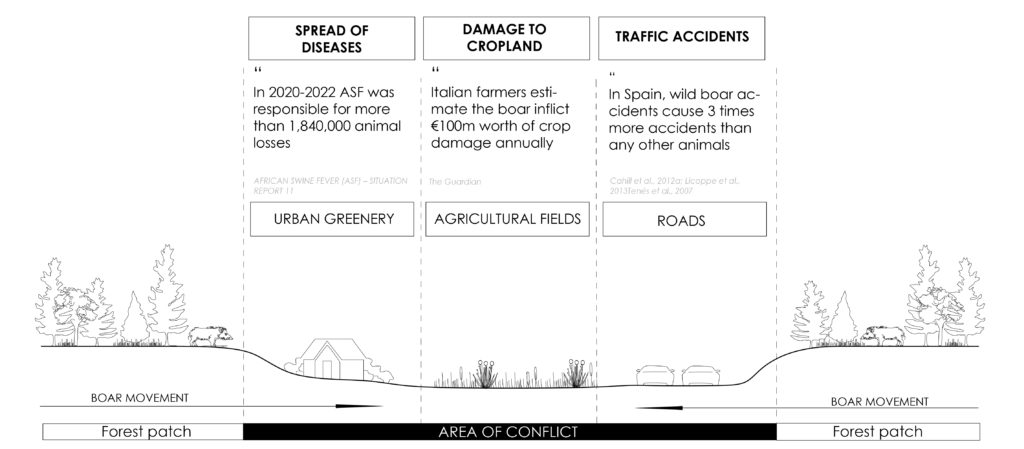
BOAR- AN ECOSYSTEM ENGINEER
Can boar not only harm, but benefit the ecosystem? Throughout our research we found out that boar’s rooting
can help regenerate soil in poor landscapes. Although there is a common attitude that digging destroys roots
and ecosystems, scientific evidence suggests that it also can regenerate it. As a result, we come down to our proposal
of cohabitating through the rewildered corridors, providing boars equal rights and seeing them as an ecosystem
protagonist who rather heals and creates than destroys.
CASE STUDY- BARCELONA METROPOLITAN AREA
There are 250.000 boar living in the forests of Catalonia. Majority is concentrated around Girona, but
Collserola park is becoming increasingly populated as well. Many forest patches are bordering Barcelona which
inevitably causes bigger and bigger natural habitat fragmentation effects. As a result, more opportunities for boar
and human conflict emerge.

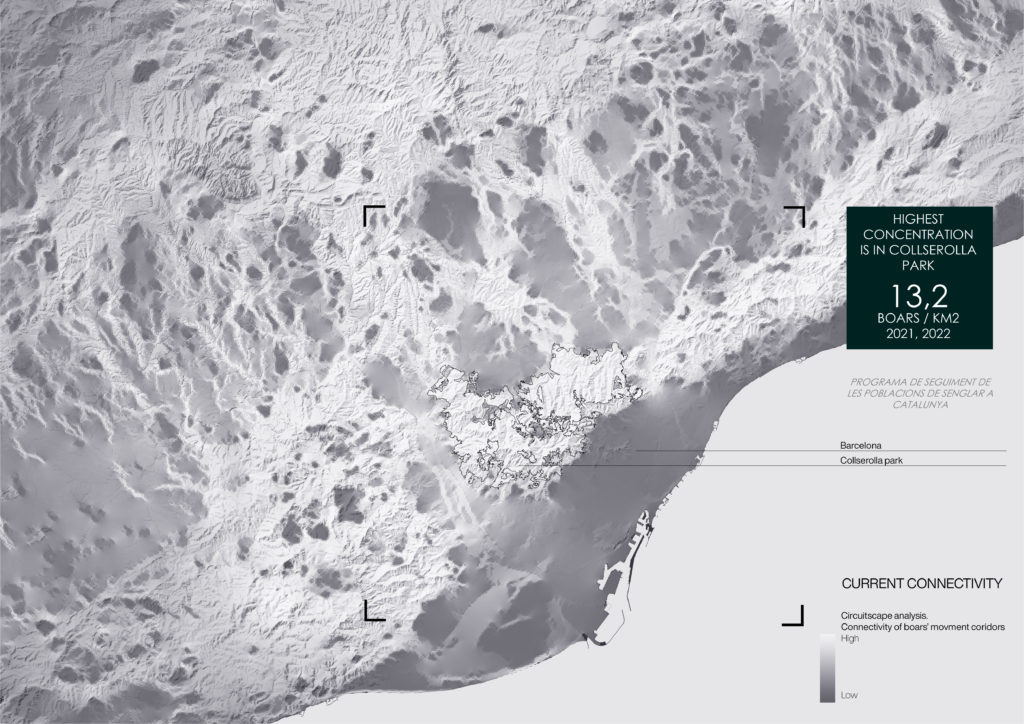
IDENTIFICATION OF CONFLICT
We were interested in how boar move in these fragmented conditions.
Having as a starting point the natural fragmentation of Barcelona’s surroundings this project is locating possible
conflicts between boar movement and human activity using two methods of analysis. The “point” method and the “corridor”
method. For the first one, we ran a connectivity analysis based on land uses and we identified defined areas of
natural connectivity especially in peri-urban areas. For the second one, by creating three groups of land uses where boar can find
food we overlapped the areas of the highest connectivity with the local dominant aiming to collect all the possible points
of conflict around Barcelona.
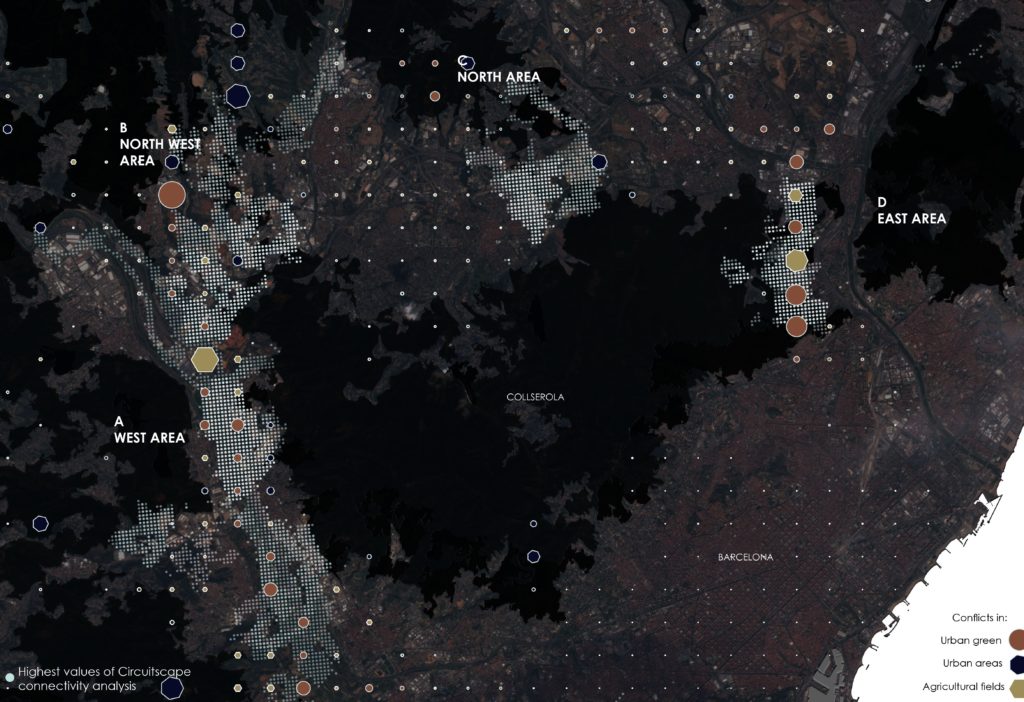
SELECTED ZONES WITH BEST REWILDERING OPPORTUNITIES
By using the two methods of analysis, we identified the four main corridors of connectivity between Collserola
Natural Park and its environments. The four areas are visualized below related to the existing identity of each area, the main
stakeholders that potentially could relate to the project as well as the natural connectivity for each selected area.
PROPOSAL- STRATEGIES AND TOOLS
The project consists of 4 main strategies and tools:
– Wildlife management is applied to main wildlife corridor, which was identified using two river streams;
– Permaculture strategy puts focus on existing agricultural fields. It explores tools to share the land with boar in
specific seasons by letting them improve the soil for the upcoming plantation. Also farms act as a buffer
surrounding wildlife corridor;
– Landscape elements aims to guide boar movement in a places with a direct contact with people;
– Wildlife crossings separate flows of boar and people.
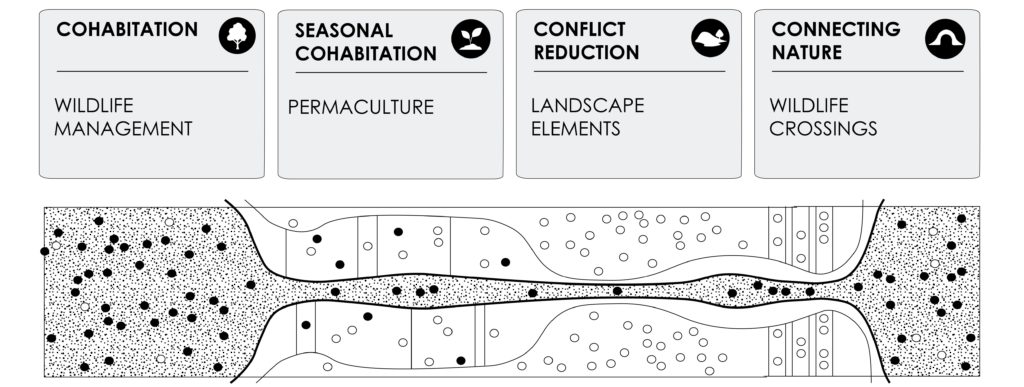
SELECTED CORRIDOR FOR REWILDERING
Speaking about the city’s future, have you ever thought that you might need to deal with a wild boar? In our
example we would like to show you what a corridor could look like, emphasizing on the area of our masterplan
located along the Llobregat river. Since in this case, we are using the existing roadway underpass, this project
aims to create a protected environment. In order to enhance the connectivity of the corridor, a river overpass is used as
part of our wildlife crossings strategy. The proposed bridge is a timber construction with a surface made with compressed
natural materials. The areas where the bridge meets the riversides are exposed gardens following the landscape and storing
rainwater coming from the streams. A large part of the agricultural activity remains in the rewilded area. By controlling
seasonally the agricultural areas the local community could either protect the crops from the boar or allow them to
access whenever the soil quality is reduced. Mixed reforestation & we forest’s growth control is used as a part of the
wildlife management strategy. Some of the local trees that can be used in the selected area are: oaks,
pines and plane trees.

